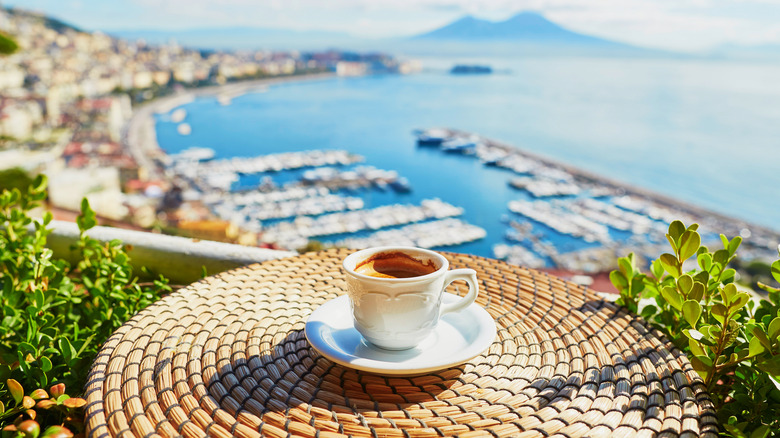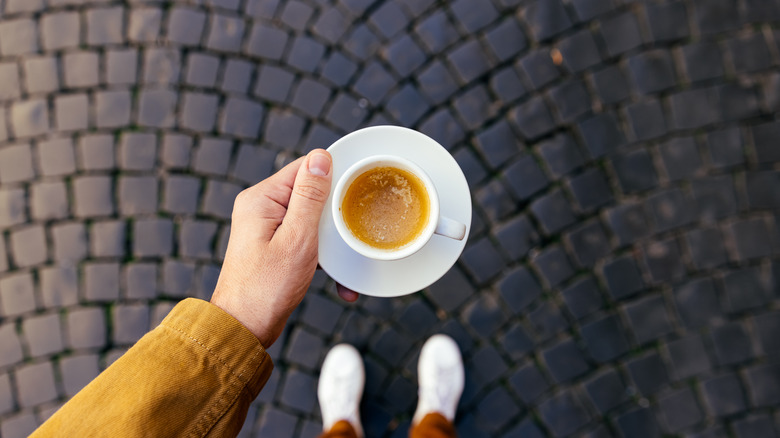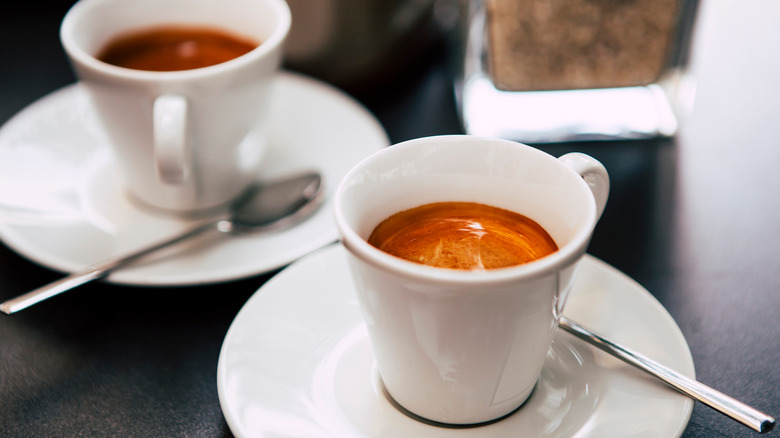How To Drink Espresso Like A True Italian
Italy has a rich coffee culture and at its core is the beloved ritual of drinking espresso. Proposed to be on UNESCO's Intangible Heritage of Humanity list, espresso is more than just a quick shot of caffeine for Italians. It's a tradition that is deeply ingrained in the country's culture, its social fabric, and its national identity – and one that is taken very seriously.
To drink an espresso like a true Italian, you need to know how to order it first. That means familiarizing yourself with Italian drink words, phrases, and local lingo. To begin with, an espresso is simply known as caffé, aka coffee. So to order a regular shot, ask for un caffè, or caffè normale (normal espresso). Then there are caffè ristretto and caffè lungo: The former is a more concentrated espresso whereas the latter is brewed with more water to dilute it. Don't confuse a lungo for a caffè americano though, which is made by adding water to a regular shot of espresso.
Caffé corretto (fittingly known as corrected espresso) features a dash of liquors such as grappa, whiskey, sambuca, or cognac (not to be confused with brandy), whereas caffé macchiato comes with a drop of frothed milk on top. You might also see chilled variations such as caffè in ghiaccio and caffé shakerato around the time of summer. The former is just espresso served on ice, whereas shakeratos are made by shaking espresso with ice until the liquid turns frothy.
To drink an espresso like an Italian, head to the bar
Always remember: An espresso is known as caffé in Italy, and a cafe is really called a bar. These bars may serve alcohol too, but their main business is dishing out hot espressos and sweet pastries to go with it. Inside these bars, things can get very intense and chaotic very quickly. Espressos are ordered al blanco (at the counter), served swiftly, and chugged down in a couple of swigs whilst still standing. The entire affair is over in about five minutes!
Central to the ritual of espresso is the concept of una pausa or a pause. Espressos mark a pause in the day, and are a way to enjoy bella vita (the beautiful life) and all its simple pleasure. It's the fast efficiency of this ritual that makes it possible to take multiple such coffee breaks in a day. You'll see throngs of Italians make several trips to a bar and gulp down their espresso over boisterous chats with the barista or their friends. However, they will seldom linger for longer than a few short minutes.
Additionally, it's an unspoken rule to only drink an espresso standing up if you're close to the bar — anywhere else can bring bad luck. If not, you could order an espresso al tavolo or at the table and enjoy a more leisurely brew. However, be prepared for the same cup of coffee to cost two or three times more for such luxury.
Stir, sip, and savor that espresso
Once you know how to order an espresso and where to find it, the next step is to savor the brown liquid properly. That begins with sipping on some water, which helps tocleanse the palate and prepare it for the rich and complex flavors to come. This is why it's common to be served a small glass of water with an order of espresso in Italian bars.
Next, stir the drink with a little spoon. This distributes the flavors and aromas evenly throughout the drink, making sure that each sip is equally robust and punchy. Never move the spoon in circles though: The correct way is to gently stir the liquid from top to bottom without clanging the spoon on the cup's walls. It's also a great way to mix any sugar that may be added to the drink. When you're done, place the spoon as it is in the saucer. Don't lick it; Don't leave it in the cup — both are transgressions of proper espresso-drinking etiquette.
Finally, remember that there is no wrong time to be drinking an espresso. While milky coffees like cappuccinos and lattes are a huge no after 11 a.m. because they are considered too heavy to digest, while espressos fly at any time of the day ... or night. In fact, nights are the only time when espressos are enjoyed at leisure, as post-dinner digestifs to finish off rich meals and extend the evening's revelries for just a little longer.



